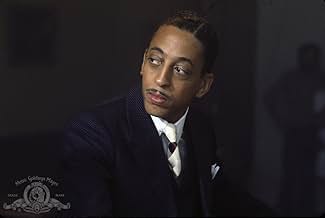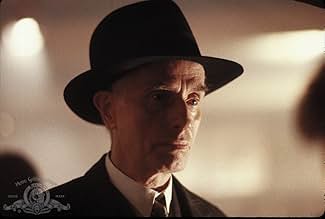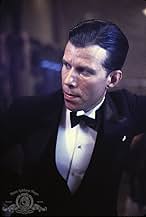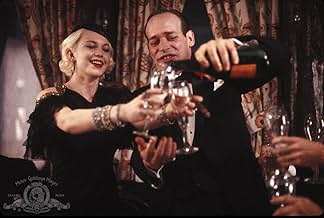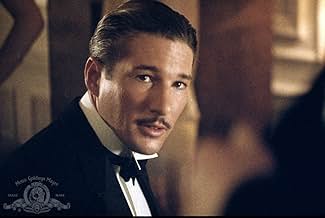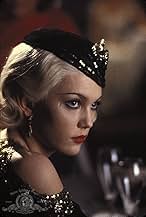NOTE IMDb
6,6/10
21 k
MA NOTE
Découvrez les musiciens de jazz, les danseurs, le propriétaire et les clients du Cotton Club dans les années 1928 à 1930 à Harlem.Découvrez les musiciens de jazz, les danseurs, le propriétaire et les clients du Cotton Club dans les années 1928 à 1930 à Harlem.Découvrez les musiciens de jazz, les danseurs, le propriétaire et les clients du Cotton Club dans les années 1928 à 1930 à Harlem.
- Réalisation
- Scénario
- Casting principal
- Nommé pour 2 Oscars
- 1 victoire et 9 nominations au total
Laurence Fishburne
- Bumpy Rhodes
- (as Larry Fishburne)
John P. Ryan
- Joe Flynn
- (as John Ryan)
Avis à la une
The first time I saw this movie I loved the music and dancing and appreciated the setting. I found it strange and couldn't follow it properly. I watched it a second and third time, partly to see the dancing again, and listen to the music, and the plot completely grew on me. I absolutely love this movie. It is complex, and extremely accurate in its portrayal of the time when gangsters owned stars. If you love jazz music and know a little about its history, you will be enraptured by this movie.
The acting is incredible, and highlights the subtle twists in the plot beautifully. The cinematography is done in a most expert fashion. Richard Gere and Gregory Hines are absolutely charming, and Diane Lane is perfect is Vera Cicero. Lonette McKee has one of the most beautiful voices you will ever hear, it is no wonder she received a Tony award. Any viewer will be surprised by the guest appearances including Nicholas Cage, Bob Hoskins, Lawrence Fishburne, and on-screen and real-life brother of Gregory, Maurice Hines. Not only one of Coppola's best, but one of the best of all time.
The acting is incredible, and highlights the subtle twists in the plot beautifully. The cinematography is done in a most expert fashion. Richard Gere and Gregory Hines are absolutely charming, and Diane Lane is perfect is Vera Cicero. Lonette McKee has one of the most beautiful voices you will ever hear, it is no wonder she received a Tony award. Any viewer will be surprised by the guest appearances including Nicholas Cage, Bob Hoskins, Lawrence Fishburne, and on-screen and real-life brother of Gregory, Maurice Hines. Not only one of Coppola's best, but one of the best of all time.
The Cotton Club is a dazzling, complex film that attempts so much it would be almost impossible for nearly any director to pull it off. But Francis Ford Coppola is not any director, so The Cotton Club is not just any movie. Rather, it succeeds at practically all levels and is certainly a film worth coming back to again and again.
Set in Harlem in the late 1920s, we are introduced to a group of Jazz Age-products, people who see themselves exactly as they are but all hope to go somewhere better. Two story lines occupy the plot; we get a good-looking young musician Dixie Dwyer (Richard Gere) who gets involved in the mob after falling for one of the gangster's girlfriends (Diane Lane) and we get the story of a very talented black dancer (Gregory Hines) trying to prove his love to a half-black and half-white chorus girl who seems to struggle with her place in this more or less racist society. Almost every night, everyone gathers at The Cotton Club, one of the most famous clubs in the city and the blacks entertain while the whites drink and watch. But Coppola gives us a view from all angles so it doesn't feel as if we are missing anything important.
One of the biggest achievements of this film is its staging of the dance sequences, which are to say the least quite exquisite. Filled with colorful costumes and some mind-boggling tap numbers, at times you may forget that this is also a gangster picture. Indeed, some scenes feel just like Coppola's The Godfather with its quick bursts of violence but also in its tone of sad, elegiac setting. People come and go and some regret the things they do, but the music lives on. The acting is also very strong as Gere and Lane are quite wonderful in their first of three films together. Both were very good-looking and they do bring out the best in each other. Two supporting actors that really do steal the show are Bob Hoskins and Fred Gwynne as a mob boss and his head bodyguard. They share a tenacity and ferociousness in their dealings, but also have one really terrific scene involving Gwynne coming to see Hoskins after being kidnapped. A young Nicolas Cage also shows here he had incredible potential.
This Broadway version of the gangster film so familiar in Hollywood refreshes both genres as we see the similarities between the two. Indeed, many of the participators in the entertainment were also involved in the mob and Coppola shows how the two lives intertwine and bring a lot of trouble to everyone. This may seem as a strange mixing of genres and story lines for some people, but it is well worth the two hours. It is funny, sad, violent, poetic but also enormously entertaining and isn't that what the movies are all about? Coppola seems to think so.
Set in Harlem in the late 1920s, we are introduced to a group of Jazz Age-products, people who see themselves exactly as they are but all hope to go somewhere better. Two story lines occupy the plot; we get a good-looking young musician Dixie Dwyer (Richard Gere) who gets involved in the mob after falling for one of the gangster's girlfriends (Diane Lane) and we get the story of a very talented black dancer (Gregory Hines) trying to prove his love to a half-black and half-white chorus girl who seems to struggle with her place in this more or less racist society. Almost every night, everyone gathers at The Cotton Club, one of the most famous clubs in the city and the blacks entertain while the whites drink and watch. But Coppola gives us a view from all angles so it doesn't feel as if we are missing anything important.
One of the biggest achievements of this film is its staging of the dance sequences, which are to say the least quite exquisite. Filled with colorful costumes and some mind-boggling tap numbers, at times you may forget that this is also a gangster picture. Indeed, some scenes feel just like Coppola's The Godfather with its quick bursts of violence but also in its tone of sad, elegiac setting. People come and go and some regret the things they do, but the music lives on. The acting is also very strong as Gere and Lane are quite wonderful in their first of three films together. Both were very good-looking and they do bring out the best in each other. Two supporting actors that really do steal the show are Bob Hoskins and Fred Gwynne as a mob boss and his head bodyguard. They share a tenacity and ferociousness in their dealings, but also have one really terrific scene involving Gwynne coming to see Hoskins after being kidnapped. A young Nicolas Cage also shows here he had incredible potential.
This Broadway version of the gangster film so familiar in Hollywood refreshes both genres as we see the similarities between the two. Indeed, many of the participators in the entertainment were also involved in the mob and Coppola shows how the two lives intertwine and bring a lot of trouble to everyone. This may seem as a strange mixing of genres and story lines for some people, but it is well worth the two hours. It is funny, sad, violent, poetic but also enormously entertaining and isn't that what the movies are all about? Coppola seems to think so.
inspired by photographs of the legendary Cotton Club in Harlem, some shots appear exactly as they were (now in colour). I noticed Dutch Schultz's slumped pose when he is shot is exactly that of the police photograph, though he died several hours later (see William Burroughs "The Last Words Of Dutch Schultz"). The actors often play too broad (Diane Lane), and Richard Gere shows his lazy, grinning acting here too. However, many notable smaller roles for Gregory Hines (and his brother), Bob Hoskins, Laurence Fishburne and others who make it well worth watching. It is true that $40 million could have been used better, but when you consider both Bob Evans and Coppola's involvement it seems with hindsight that they were asking for trouble. The music deserves special credit, as do the tap sequences (which i gather were shortened and some cut - what a shame). Mostly Duke Ellington classics. As i've already suggested the look is a perfect recreation of the time, but sadly the plot is patchy, some dialogue weak and it has been said before - there is no chemistry between the romantic leads. 9/10
This is a great movie. I personally don't think the beautiful Diane Lane could be in a bad flick, she would make the worst one good. I was impressed with Richard Geres musical ability as he played his own coronet and sounded as good as anyone I've ever heard. The dancing was superb, the costumes beautiful and the plot authentic. It took me back to the great musicals of the forties and fifties. I was raised in the waning days of the era of this movie, the thirties, and I could almost hear my Dad talking about the evils of the big cities while we listened to the radio news of gangsters and shootouts. I would recommend this movie to anyone. I rate it 10/10.
Part fictional and part non-fictional, this lavish two-hour Francis Ford Coppola film spotlights the Cotton Club, the legendary, real-life Harlem jazz nightclub that flourished in the Prohibition era of the late 1920s and early 1930s. Richard Gere plays Dixie Dwyer, a young musician who works for mobsters, in an effort to advance his career. Dwyer falls in love with Vera Cicero (Diane Lane), the girlfriend of gangster Dutch Schultz (James Remar). The Dwyer character is based loosely on real-life jazz trumpet player Bix Beiderbecke.
Throughout the film, various gangsters and bootleggers interact, sometimes violently, but much of the action centers around the Cotton Club, an establishment owned in real-life by Owney Madden, played in the film by actor Bob Hoskins. Madden would bring in Black performers to entertain a Whites-only clientèle, a truly racist policy, and a major plot point in the film's story.
The film's plot is somewhat muddled, the result of a less than stellar screenplay. And, as you would expect, the gangster characters are not terribly likable. But the film overcomes these script weaknesses with a captivating visual and musical style that is both tawdry and elegant. The corruption, the violence, and the implied sleaze are garish and tawdry to be sure. Yet, the Club's ambiance gushes with a certain elegance and glamour. It's a strange mix, but one that is entirely consistent with that era in U.S. history.
The film gets points from me for its lush, period piece costumes and production design, and adroit lighting, as well as all those jazz numbers, both sultry and flashy. Gregory Hines together with brother Maurice Hines provide some snappy tap dancing, some of which is improvised. Interestingly, their grandmother really did perform at the Cotton Club during its heyday. Also of interest in the film, viewers get to watch towering Fred Gwynne, who plays Frenchy, the oh-so-serious assistant to Owney Madden; the two of them engage in some interesting dialogue.
Although the script's story and characters are less than ideal, I enjoyed the film a lot, mostly as a result of the tawdry and elegant visual style combined with the lavish jazz numbers. If you're interested in gangster movies or the Prohibition era of American history, this film is a must-see.
Throughout the film, various gangsters and bootleggers interact, sometimes violently, but much of the action centers around the Cotton Club, an establishment owned in real-life by Owney Madden, played in the film by actor Bob Hoskins. Madden would bring in Black performers to entertain a Whites-only clientèle, a truly racist policy, and a major plot point in the film's story.
The film's plot is somewhat muddled, the result of a less than stellar screenplay. And, as you would expect, the gangster characters are not terribly likable. But the film overcomes these script weaknesses with a captivating visual and musical style that is both tawdry and elegant. The corruption, the violence, and the implied sleaze are garish and tawdry to be sure. Yet, the Club's ambiance gushes with a certain elegance and glamour. It's a strange mix, but one that is entirely consistent with that era in U.S. history.
The film gets points from me for its lush, period piece costumes and production design, and adroit lighting, as well as all those jazz numbers, both sultry and flashy. Gregory Hines together with brother Maurice Hines provide some snappy tap dancing, some of which is improvised. Interestingly, their grandmother really did perform at the Cotton Club during its heyday. Also of interest in the film, viewers get to watch towering Fred Gwynne, who plays Frenchy, the oh-so-serious assistant to Owney Madden; the two of them engage in some interesting dialogue.
Although the script's story and characters are less than ideal, I enjoyed the film a lot, mostly as a result of the tawdry and elegant visual style combined with the lavish jazz numbers. If you're interested in gangster movies or the Prohibition era of American history, this film is a must-see.
Le saviez-vous
- AnecdotesWhen Francis Ford Coppola called up Bob Hoskins to offer him a part, the actor didn't believe it was really him. Coppola introduced himself, to which Hoskins replied, "Yeah, and this is Henry the fucking Eighth", and hung up.
- GaffesDuring the montage song Ill Wind there is a shot of coins and bills being poured out. The dimes in the shot are Roosevelt dimes, not produced until 1946.
- Crédits fousIn the original version, the opening credits were intercut with dancers performing "The Mooche." In the 2019 revision, the dancing is eliminated and the credits roll straight through, but have been joined with straight cuts rather than dissolves. Additionally, Coppola has changed his billing from "Francis Coppola" to "Francis Ford Coppola." Finally, restoration credits have been added after the end titles.
- Versions alternativesIn 2019, Lionsgate released a director's cut running 139 minutes, titled "The Cotton Club Encore". This version gave more space to the Williams brothers and Lila Rose, restoring three full musical numbers and extending others, and trimming scenes with impersonations of 1920s celebrities.
- ConnexionsEdited into Lonette McKee: Ill Wind (1984)
- Bandes originalesHow Come You Love Me Like You Do?
Written by Gene Austin and Roy Bergere
Meilleurs choix
Connectez-vous pour évaluer et suivre la liste de favoris afin de recevoir des recommandations personnalisées
- How long is The Cotton Club?Alimenté par Alexa
Détails
- Date de sortie
- Pays d’origine
- Langues
- Aussi connu sous le nom de
- El Cotton Club. Centro de la mafia
- Lieux de tournage
- Prospect Hall, Brooklyn, Ville de New York, New York, États-Unis(church, order given at bar, Hoofer's Club, ballroom proposal)
- Sociétés de production
- Voir plus de crédits d'entreprise sur IMDbPro
Box-office
- Budget
- 58 000 000 $US (estimé)
- Montant brut aux États-Unis et au Canada
- 25 928 721 $US
- Week-end de sortie aux États-Unis et au Canada
- 2 903 603 $US
- 16 déc. 1984
- Montant brut mondial
- 25 928 721 $US
- Durée2 heures 9 minutes
- Couleur
- Rapport de forme
- 1.85 : 1
Contribuer à cette page
Suggérer une modification ou ajouter du contenu manquant

Lacune principale
By what name was Cotton Club (1984) officially released in India in English?
Répondre


